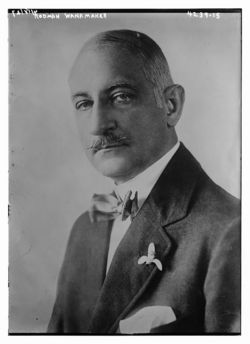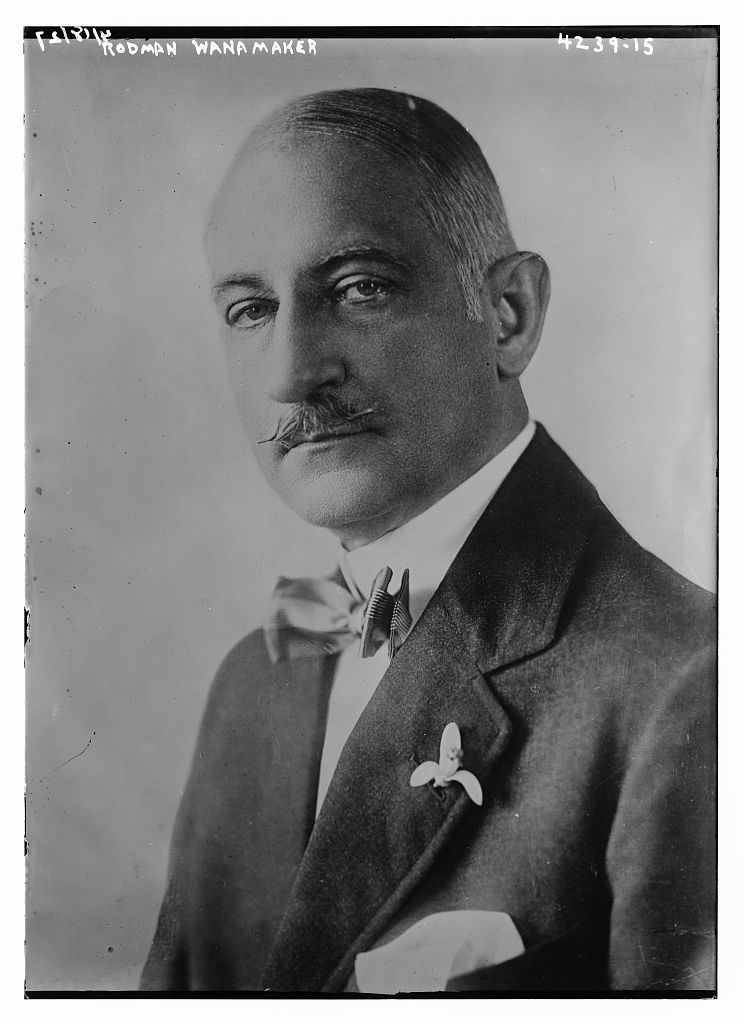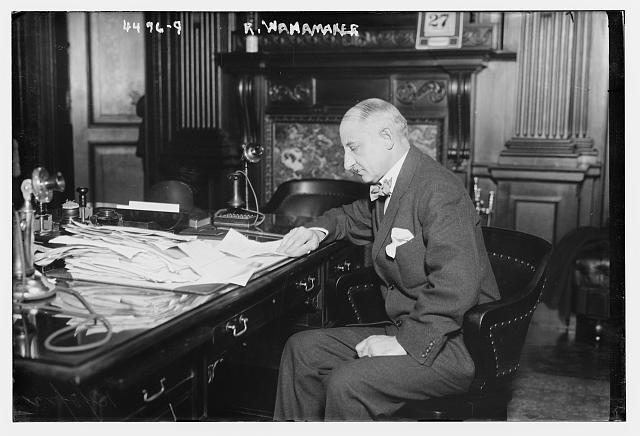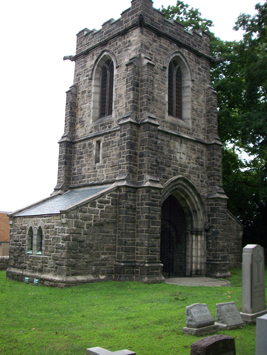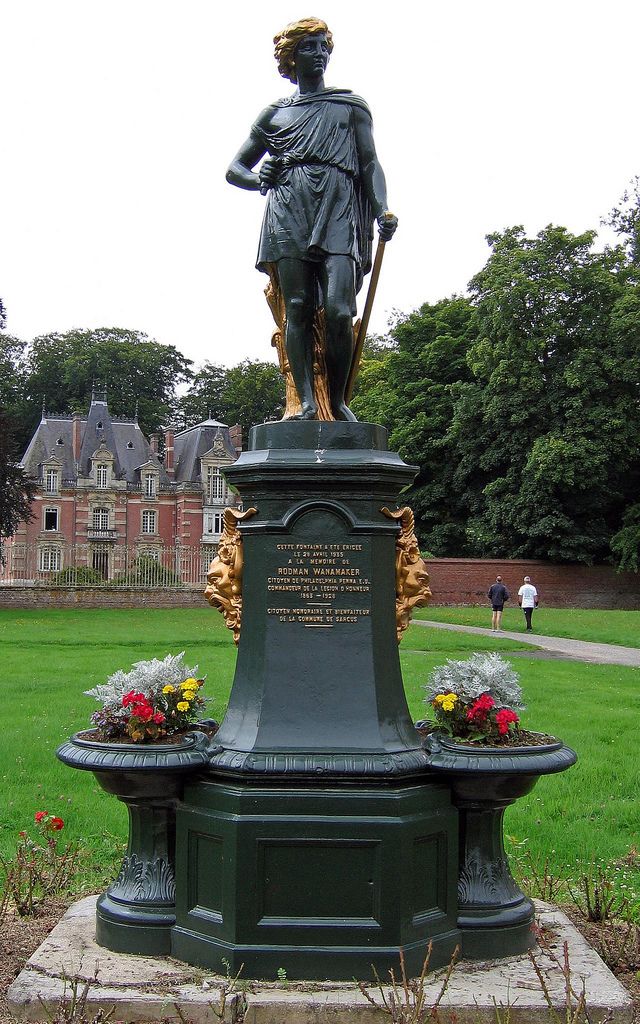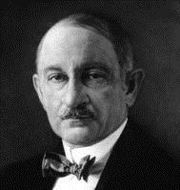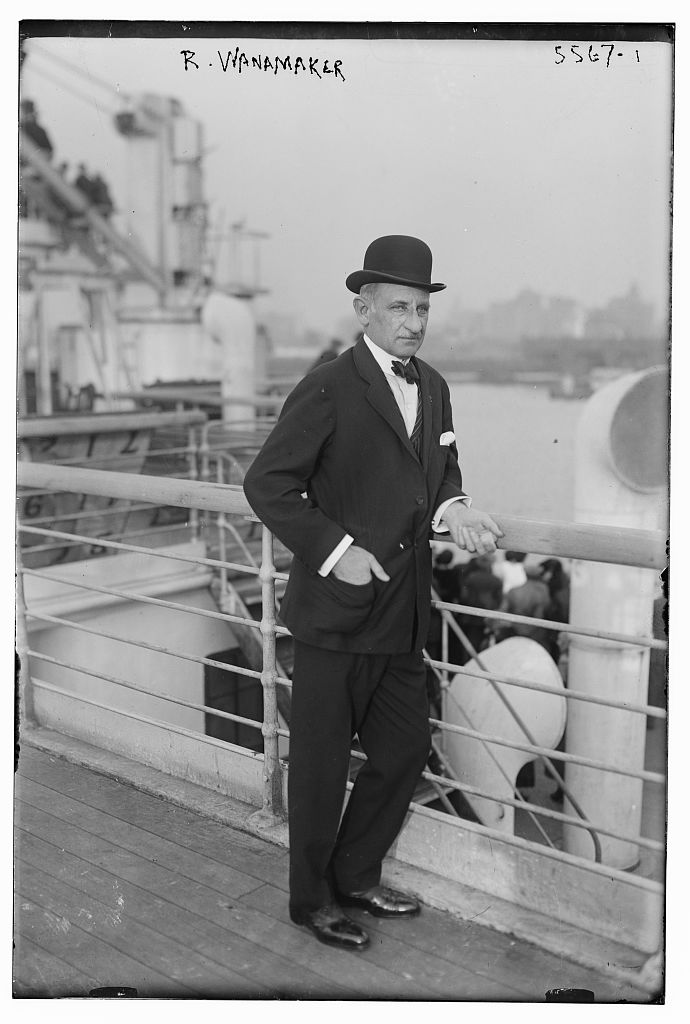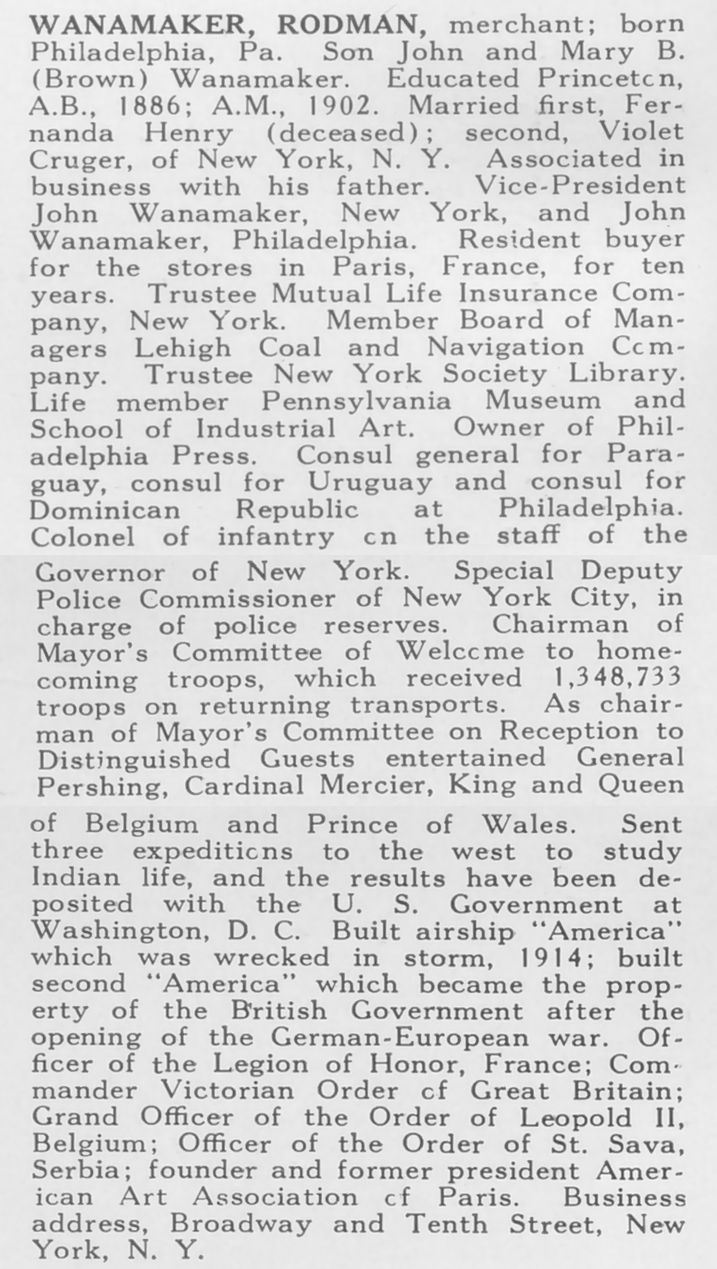Lewis Rodman Wanamaker was born on February 13th 1863 in Philadelphia to John Wanamaker, retail merchant by his wife Mary Erringer Brown. He was educated at the College of New Jersey (now Princeton University), graduating in 1886. The same year he joined his father's business.
Wanamaker was married on November 4th 1886 at St. Mark's Episcopal Church in Philadelphia to Fernanda Antonia Henry of Philadelphia, a native from France.
In 1889 his father installed him as the resident manager of John Wanamaker Department Store in Paris, France. He was to remain abroad for 10 years. In 1896, after his father had acquired the former A.T. Stewart business in New York, Rodman Wanamaker helped to revolutionize the department store business by featuring top quality goods. He is credited with fueling an American demand for French luxury merchandise. After the untimely death in 1908 of Rodman's older brother, Thomas B. Wanamaker, the heir-apparent to the Wanamaker empire, his father started to turn over the day-to-day business operations to him. Upon his father's death in 1922, Rodman Wanamaker took complete control and management of all Wanamaker businesses. No other American retail merchandising business on such a large scale was in the hands of one single individual.
Rodman Wanamaker suffered from kidney disease in the last decade of his life, a condition that took its toll on his health. Rodman Wanamaker had a son, Captain John Wanamaker, and two daughters, Fernanda and Marie Louise. The son had a number of personal problems that made his choice as successor to the father increasingly problematic. After his death in Atlantic City on March 9th 1928 control of the stores passed to a board of trustees charged with serving the interests of the surviving Rodman Wanamaker family.
Rodman Wanamaker was known for carrying extremely large life-insurance policies, totaling in the millions of dollars.
Rodman Wanamaker sponsored numerous important liturgical arts commissions, his legacy includes a sterling silver altar and silver pulpit at the chapel of the Queen's estate in Sandringham, England, including a large processional cross for Westminster Abbey and important additions to his Philadelphia parish of St. Mark's Episcopal Church, notably the sumptuously appointed Lady Chapel where his first wife Fernanda is buried.
Between 1908 and 1913, Wanamaker commissioned three photographic expeditions to the American Indians intended to document a vanishing way of life and make the Indian "first-class citizens" to save them from extinction. At that time, Indians were viewed as a "Vanishing Race," and efforts were made to bring them increasingly into the mainstream of American life, often at the expense of their culture and traditions. Joseph K. Dixon was the photographer. On the first expedition, he made many portraits and captured scenes of Indian life. Wanamaker co-published a book with Dixon titled "The Vanishing Race." The second expedition in 1909 involved a motion filming a reenactment of the Battle of the Little Big Horn. In 1913, Wanamaker sponsored the groundbreaking for a National Memorial to the First Americans on Staten Island. The monument was never built. The third expedition, the "Expedition of Citizenship," took place in 1913. For it, the American flag was carried to many tribes, and their members were invited to sign a declaration of allegiance to the United States. The resulting large bromide prints were presentation photographs, such collections having been placed in several museums. Mostly, the subjects are Blackfeet, Cheyennes, Crows, Dakotas, and other northern plains tribes.
In 1908 Rodman Wanamaker initiated the Millrose Games, which became widely known as perhaps the most prestigious indoor track-and-field event in the world. They are now held at Madison Square Garden in New York City. (Millrose was Wanamaker's country estate near Jenkintown, Pennsylvania) He also inaugurated the Wanamaker Mile, and reportedly began the tradition of playing The Star Spangled Banner at a sporting event.
On January 17, 1916, Wanamaker invited a group of 35 prominent golfers and other leading industry representatives, including the legendary Walter Hagen, to a luncheon at the Taplow Club in New York for an exploratory meeting, which resulted in the formation of the Professional Golfers' Association of America (PGA). During the meeting, Wanamaker hinted that the newly formed organization needed an annual all-professional tournament, and offered to put up $2,500 and various trophies and medals as part of the prize fund. Wanamaker's offer was accepted, and seven months later, the first PGA Championship was played at Siwanoy Country Club in Bronxville, NY. Since 1916, the PGA Championship has evolved into one of the world's premier sporting events. Each summer, one of the nation's most outstanding golf facilities hosts golf's best professionals, as they compete for the Wanamaker Trophy.
He accepted an appointment during World War I as Special Deputy Police Commissioner in New York City, greeting distinguished guests from around the world and helping organize the victory parade for General John J. Pershing and the returning doughboys. He purchased more World War I bonds than anyone else in the United States, and generously allowed the use of his residences for the war effort, "virtually putting his enormous wealth at the disposal of the United States." After the war Wanamaker acted as something of an official greeter for the City of New York, often lending his Landaulette Rolls-Royce for ticker-tape parades.
Lewis Rodman Wanamaker was born on February 13th 1863 in Philadelphia to John Wanamaker, retail merchant by his wife Mary Erringer Brown. He was educated at the College of New Jersey (now Princeton University), graduating in 1886. The same year he joined his father's business.
Wanamaker was married on November 4th 1886 at St. Mark's Episcopal Church in Philadelphia to Fernanda Antonia Henry of Philadelphia, a native from France.
In 1889 his father installed him as the resident manager of John Wanamaker Department Store in Paris, France. He was to remain abroad for 10 years. In 1896, after his father had acquired the former A.T. Stewart business in New York, Rodman Wanamaker helped to revolutionize the department store business by featuring top quality goods. He is credited with fueling an American demand for French luxury merchandise. After the untimely death in 1908 of Rodman's older brother, Thomas B. Wanamaker, the heir-apparent to the Wanamaker empire, his father started to turn over the day-to-day business operations to him. Upon his father's death in 1922, Rodman Wanamaker took complete control and management of all Wanamaker businesses. No other American retail merchandising business on such a large scale was in the hands of one single individual.
Rodman Wanamaker suffered from kidney disease in the last decade of his life, a condition that took its toll on his health. Rodman Wanamaker had a son, Captain John Wanamaker, and two daughters, Fernanda and Marie Louise. The son had a number of personal problems that made his choice as successor to the father increasingly problematic. After his death in Atlantic City on March 9th 1928 control of the stores passed to a board of trustees charged with serving the interests of the surviving Rodman Wanamaker family.
Rodman Wanamaker was known for carrying extremely large life-insurance policies, totaling in the millions of dollars.
Rodman Wanamaker sponsored numerous important liturgical arts commissions, his legacy includes a sterling silver altar and silver pulpit at the chapel of the Queen's estate in Sandringham, England, including a large processional cross for Westminster Abbey and important additions to his Philadelphia parish of St. Mark's Episcopal Church, notably the sumptuously appointed Lady Chapel where his first wife Fernanda is buried.
Between 1908 and 1913, Wanamaker commissioned three photographic expeditions to the American Indians intended to document a vanishing way of life and make the Indian "first-class citizens" to save them from extinction. At that time, Indians were viewed as a "Vanishing Race," and efforts were made to bring them increasingly into the mainstream of American life, often at the expense of their culture and traditions. Joseph K. Dixon was the photographer. On the first expedition, he made many portraits and captured scenes of Indian life. Wanamaker co-published a book with Dixon titled "The Vanishing Race." The second expedition in 1909 involved a motion filming a reenactment of the Battle of the Little Big Horn. In 1913, Wanamaker sponsored the groundbreaking for a National Memorial to the First Americans on Staten Island. The monument was never built. The third expedition, the "Expedition of Citizenship," took place in 1913. For it, the American flag was carried to many tribes, and their members were invited to sign a declaration of allegiance to the United States. The resulting large bromide prints were presentation photographs, such collections having been placed in several museums. Mostly, the subjects are Blackfeet, Cheyennes, Crows, Dakotas, and other northern plains tribes.
In 1908 Rodman Wanamaker initiated the Millrose Games, which became widely known as perhaps the most prestigious indoor track-and-field event in the world. They are now held at Madison Square Garden in New York City. (Millrose was Wanamaker's country estate near Jenkintown, Pennsylvania) He also inaugurated the Wanamaker Mile, and reportedly began the tradition of playing The Star Spangled Banner at a sporting event.
On January 17, 1916, Wanamaker invited a group of 35 prominent golfers and other leading industry representatives, including the legendary Walter Hagen, to a luncheon at the Taplow Club in New York for an exploratory meeting, which resulted in the formation of the Professional Golfers' Association of America (PGA). During the meeting, Wanamaker hinted that the newly formed organization needed an annual all-professional tournament, and offered to put up $2,500 and various trophies and medals as part of the prize fund. Wanamaker's offer was accepted, and seven months later, the first PGA Championship was played at Siwanoy Country Club in Bronxville, NY. Since 1916, the PGA Championship has evolved into one of the world's premier sporting events. Each summer, one of the nation's most outstanding golf facilities hosts golf's best professionals, as they compete for the Wanamaker Trophy.
He accepted an appointment during World War I as Special Deputy Police Commissioner in New York City, greeting distinguished guests from around the world and helping organize the victory parade for General John J. Pershing and the returning doughboys. He purchased more World War I bonds than anyone else in the United States, and generously allowed the use of his residences for the war effort, "virtually putting his enormous wealth at the disposal of the United States." After the war Wanamaker acted as something of an official greeter for the City of New York, often lending his Landaulette Rolls-Royce for ticker-tape parades.
Family Members
Sponsored by Ancestry
Advertisement
Explore more
Sponsored by Ancestry
Advertisement
